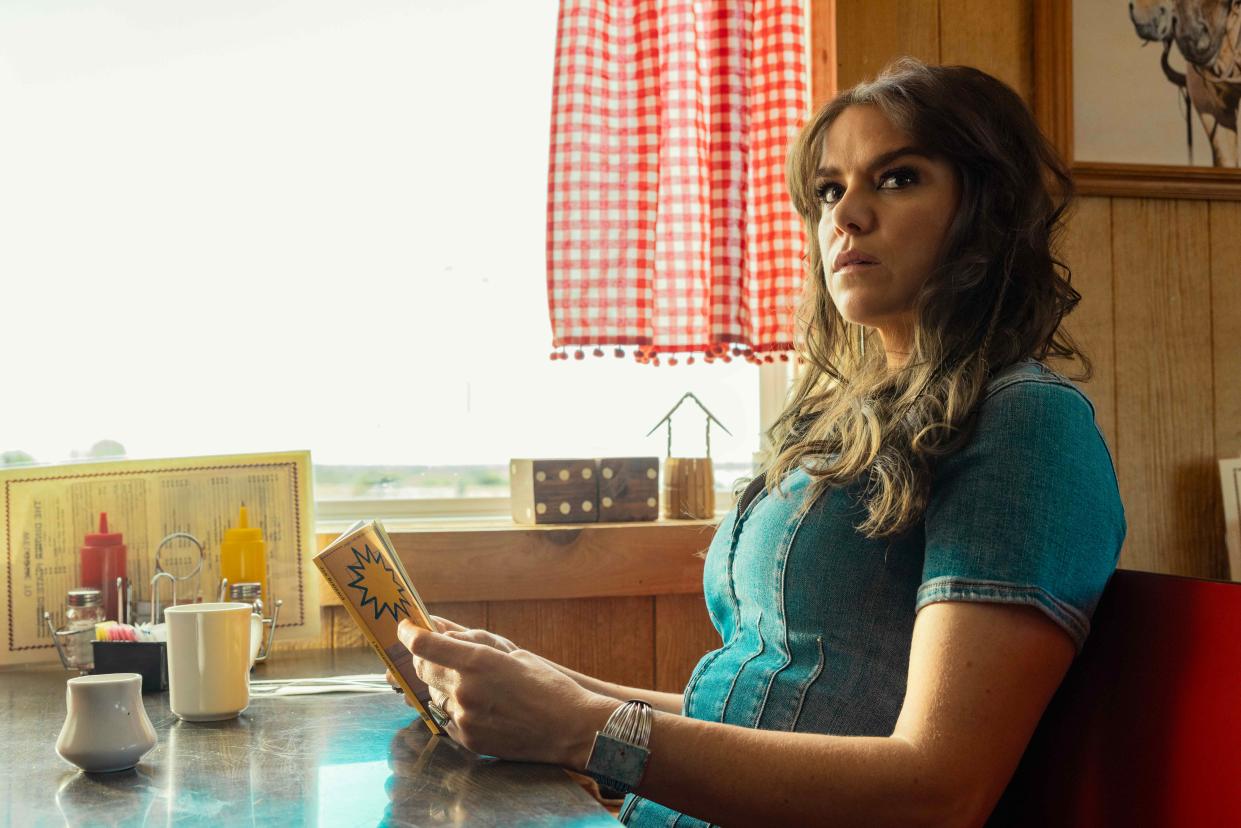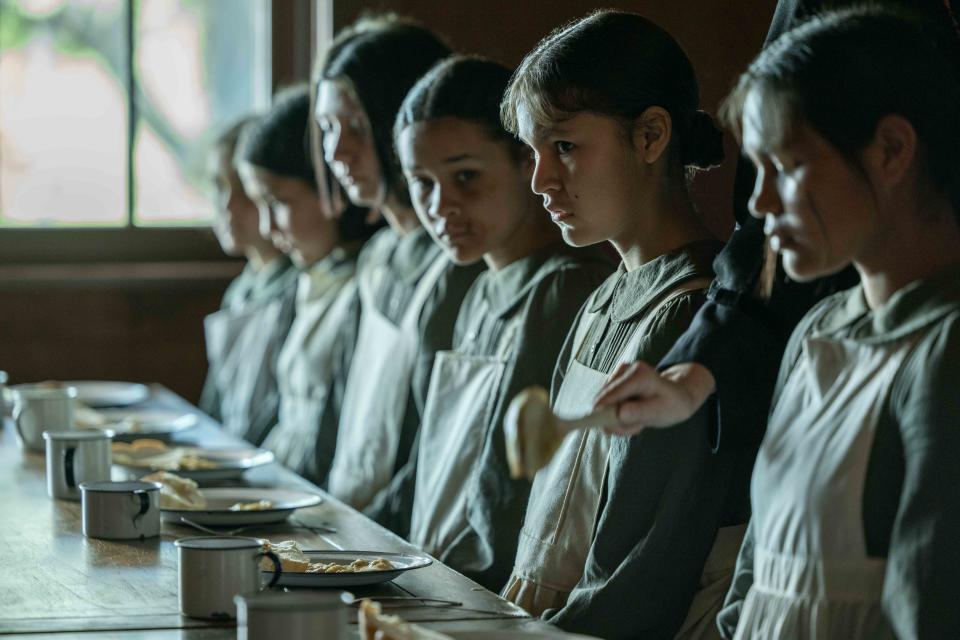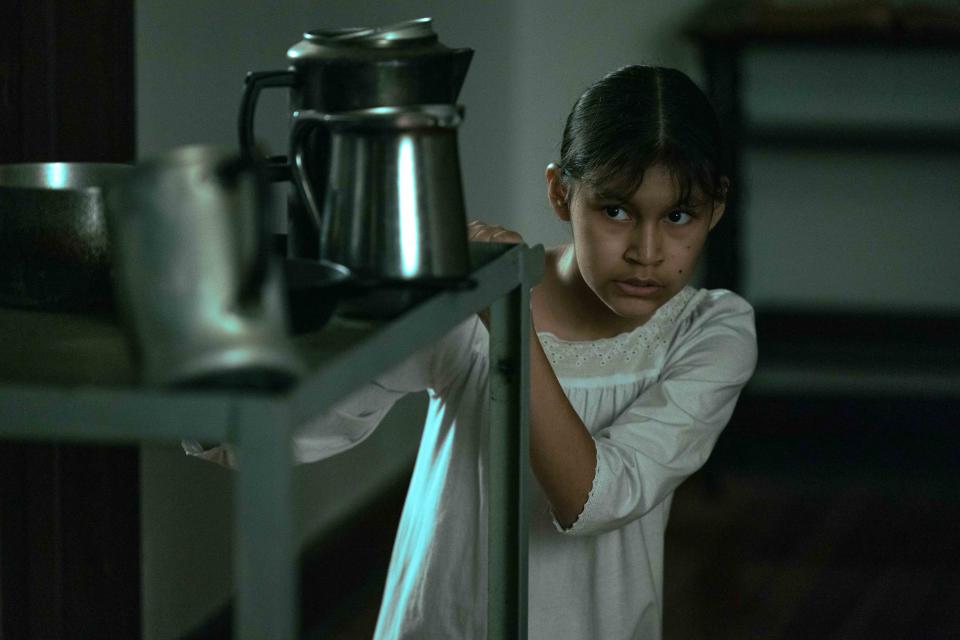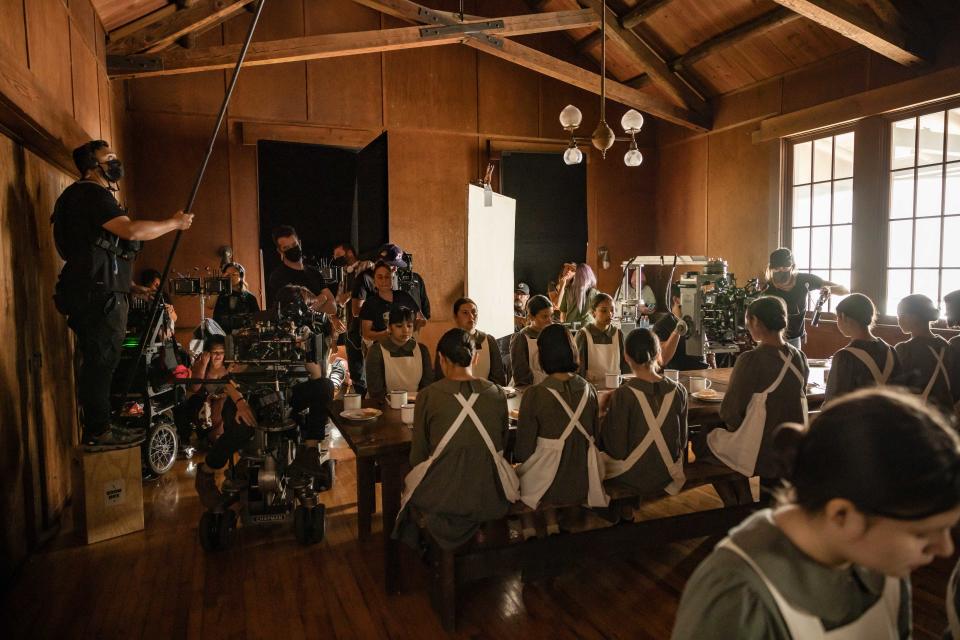In Episode 3, ‘Reservation Dogs’ Distorts Its Audio to Displace the Audience

- Oops!Something went wrong.Please try again later.
- Oops!Something went wrong.Please try again later.
“Reservation Dogs” might be ending this season, but the FX series is leaving everything on the field, both in terms of storytelling and technical ambition. Episode 3, “Deer Lady,” is a simple enough vehicle (pun only somewhat intended) for the recurring character played by Kaniehtiio Horn, who we’ve seen cruising the Oklahoma byways on the hunt for bad men. But Sterlin Harjo and his team take the opportunity to do more than provide an origin story for Deer Lady, her fabulously free hair, and the set of antlers she wields. It folds her into a piece of American history and uses a smart blend of sound and score to make us feel as disoriented and terrified as the girl (Georgeanne Growingthunder) who would become Deer Lady.
The show sets her beginning, seen in flashback, at an Native boarding school (which do still exist, although since the passage of the Indian Child Welfare Act of 1978, the federal government no longer has a policy of kidnapping children in order to “civilize” them). It was written into Sterlin Harjo’s script that as soon as the native children, including young Deer Lady, arrive at the school, nuns start yelling at them in a language (English) they can’t understand. But the way in which that dialogue got manipulated to create the right effect was a matter of trial and error, according to sound supervisor Patrick Hogan.
More from IndieWire
'Telemarketers' Review: The Safdies-Produced HBO Documentary Is a Rowdy, Eye-Opening Exposé
Rob Lowe Says Leaving 'Unhealthy' Situation on 'The West Wing' Was 'The Best Thing I Ever Did'
“[Director Danis Goulet] did takes where the actors just spoke normally, then they also had the actors kind of speaking gibberish, making it up as they go,” Hogan told IndieWire. “The problem with the gibberish version was — it’s kind of funny, it kind of started sounding like they were speaking some sort of weird German-Dutch hybrid. It didn’t sound necessarily like the young people just didn’t understand people who were speaking English. It [raised the question] of, like, were these Dutch missionaries?”
Hogan, the show’s editors Varun Viswanath and Patrick Tuck, and the rest of the post team tried a number of solutions, including having the actors come back and deliver the lines in ADR in a stilted, mixed-up version of English where the word order of sentences was completely scrambled; this way, the lines wouldn’t sound like a different, foreign language but the overall effect would still be unintelligible. “When we recorded each line by itself, I thought [that approach] was really going to work,” Hogan said. “But then when we played back the whole episode and you heard all the lines, one after the other, it became a case of, ‘Why are they talking weird?’ It was a little bit [too close to] Yoda.”
Eventually, Hogan and dialogue editor David Beadle decided they needed to manipulate the quality of the audio itself. “For little kids, adults are big and scary, and especially these people being so horrible to these kids. So we want to make them seem that big and that scary to the adult audience who’s watching,” Hogan said. The sound team pitched the adults’ voices down, making a combination of nonsense ad-libs and mismatched English sound as booming as a dragon’s bellow.

Hogan then further shaped the pitched-down dialog by reversing it. “At the end of the day, the reversing creates the right feeling of disorientation that we needed,” Hogan said. “There was no way to get there without adding that. Because even if you didn’t reverse it, no matter what we did, there were things that were recognizable in [the English dialog]. The whole point was, it had to be completely disorienting. I just shaped it a little bit more and gave it a little bit of texture.”
Hogan intentionally utilized a similar process for the Deer Spirit the young girl encounters when she runs away from the school after the nuns have taken away her friend Koda (Michael Podemski) to beat him. The initial idea was that the spirit would communicate more lyrically, almost through music, and so the sound team consulted composer Mato Wayuhi for a layer of score they could build the sound design off of. “It was cool, but what it lacked, though, was the specificity of the Deer Spirit talking directly to this girl,” Hogan said.
Deer Spirit’s dialogue was recorded in Kiowa, an endangered language that has less than 20 native speakers left. Language consultant Warren C. Queton helped coach the young actors through their lines in Kiowa for the flashbacks while the show called on native speaker Aykeemah to read the lines for the Doe.
Hogan then tried pitching that dialogue down as well. “It tied to that same perspective of [dialogue coming from] someone bigger and more powerful than her. But being bigger and more powerful doesn’t mean you have to be bad to someone,” Hogan said. “In the end, we blended the worlds to make sure that it was a real communication between the two of them. But we still kept that music. The sound design is in there to give it a very lyrical quality, so that it is this deeper communication [that the young girl is] understanding.”

Crafting the underlying music for a spirit was the least of Wayuhi’s challenges on Episode 3. Whether mixing choral elements, electronic bobs, sly riffs on the keyboard or tactile drumming, the music on “Reservation Dogs” is almost always a jam. Wayuhi approaches each season as its own kind of “mini-movie,” musically representing each of the characters and their growing pains through a few chosen motifs each year. But representing the experience of the native boarding school required Wayuhi to summon up a different kind of sonic darkness.
“I can’t even imagine not only the cacophony but just the cognitive dissonance of what it was like for those kids, and I think the show does a really good job of depicting that,” Wayuhi told IndieWire. “This episode was insane to score. I needed, like, therapy after — not real therapy, but just in terms of having self-care afterward. [I was] laying it all on the line. I had an urgency to pay respect to the sacrifices of my ancestors.”
Wayuhi and Harjo spoke about the atmosphere on set, shooting in the remains of an actual native boarding school, and the overwhelming drive from the entire “Reservation Dogs” team to depict the story with unflinching emotional honesty.
“They had people coming in and smudging and saying prayers to pay respect to the actual events in that school. And so I think musically, I wanted to create it from a place of verisimilitude. I didn’t want to over-sensationalize anything and I also wanted to create a soundscape that was very discordant, that called home to what it still feels like to be a native, whether in a predominantly white institution or in school,” Wayuhi said.

The result is a handful of cues that stand apart from the rest of Wayuhi’s work on “Reservation Dogs” for their sheer eeriness. The score, used sparingly in the flashbacks, works hand in hand with the whooshes and drones Hogan and his team slipped onto the soundtrack whenever the nuns appeared.
The main challenge and the longest cue in the episode for Wayuhi was the end credits sequence. It begins during one last flashback of Koda and the young girl planning to run away to go fishing, lingers on a shot of Deer Lady’s truck rolling up a dirt road, and then there’s a hard cut to a shot of Koda’s grave, at which point the credits roll. “It was a challenge to find a median between hopefulness and hopelessness. And I think it brought a lot out of me to score that last sequence,” Wayuhi said. “I had to find something within Deer Lady that still had hope and still had love.”
Wayuhi created a piece that perches delicate keys and strings for this sequence, letting a melody play out and then fade for a beat before being taken up again. The tenderness, pace, and slowing rising and fading arc of the piece make the music sound like ripples on water, or like breathing; the effect, mirroring the Deer Lady keeps moving through her own life, is happy and sad all at once.
“I want [audiences to feel] that there is such a deep reverence for community within all of us that we sometimes have to go and find. And also from a native and indigenous standpoint, you know, I think what the show’s done is just further humanize our experience,” Wayuhi said. “Which is such a hard thing, because if you look at cinema as a concept and as an art form, a lot of it is in opposition to natives. It’s literally designed against us, to dehumanize us, to portray us in a damaging, subjugated way. So this show is so revolutionary in its humanization of who we are and also when we are, too. I think it brought us to the modern era.”
New episodes of “Reservation Dogs” premiere Wednesdays on Hulu.
Best of IndieWire
Sign up for Indiewire's Newsletter. For the latest news, follow us on Facebook, Twitter, and Instagram.

